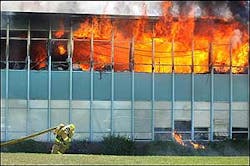Electrical Problem Was Cause of Fire at Junior High in Utah
SALT LAKE CITY (AP) -- The fire that destroyed Wasatch Junior High was caused by an unknown electrical problem, state fire investigators said Tuesday.
The fire appears to have started in a computer server in a storage room off the media center, said State Fire Marshal Ron Morris.
''Between fire smoke and water damage, the school is around 60 percent destroyed,'' Utah Fire Authority Capt. Gaylord Scott added.
Scott said investigators found nothing to contradict information from the school's principal, who along with another man, had tried to extinguish the flames shooting from the computer server about 12:30 p.m. Monday.
Granite School District officials were meeting Tuesday to begin discussions about where to hold classes for the schools 850 students when the school year begins Aug. 29.
Scott said the district was also ''making preparations to secure the building,'' and had yet to decide if teachers and administrators could be let inside to try to recover any belongings.
Determining whether the building is a ''complete loss'' is also up to the district and its insurance company, Morris said.
Firefighters monitored the smoldering remains of the school through the night, finally leaving the facility about 1 p.m. Tuesday, Scott said.
Battling the six-alarm blazed was hampered by water problems _ both the amount of water available and with the water pressure, Scott said.
The normal water pressure firefighters get from hydrants is 1,500 to 2,000 gallons per minute, Scott said. At one point Monday some firefighters were getting less than 700 gallons per minute, he said.
Scott said that while new fire hydrants are connected with an 8-to 10-inch water main, the hydrants surrounding the school were all fed by 4- to 6-inch mains.
Firefighters were also forced to deal with the size of openings on the hydrants themselves. The area is equipped with older hydrants, which have smaller openings than newer ones.
The school did not have an indoor fire sprinkler system or fire walls in the attic because those were not required under the fire code when the school was built in 1959.
Scott said he didn't know whether the outcome would have been any different even with a better water supply.
Related Articles:
